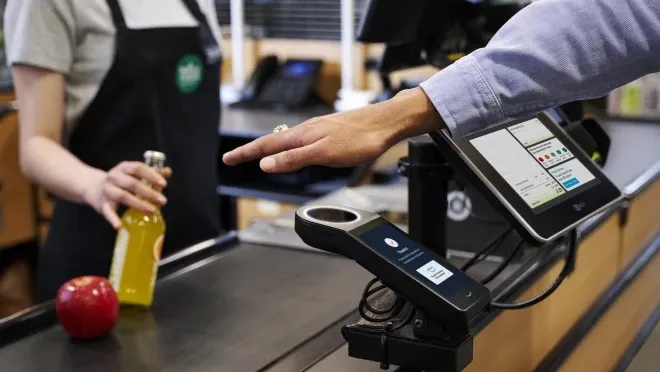Amazon One is a contactless identity service that utilises palm recognition technology. Launched in 2020, it allows users to make payments, enter secure locations, and identify themselves with a simple hand wave. This new technology aims to streamline everyday interactions by offering a faster and more hygienic alternative to traditional methods like swiping cards or entering PINs.
The power of your palm print
Unlike facial recognition, which has faced privacy concerns, Amazon One focuses on the unique characteristics of your palm. Your palm’s intricate network of lines, creases, and patterns acts as a personal identifier. When you sign up for Amazon One, the system captures a high-resolution image of your palm using a particular device. This image is then converted into a “palm signature,” a unique identifier stored securely in the cloud.
Read also: Amazon plans €1 billion Investments on electric vehicle fleet
Convenience at your fingertips (Well, Palm)
The Amazon One app, recently launched in March 2024, has made signing up for the service even more accessible. You can now create your profile from the comfort of your home. Download the app, photograph your palm, and link a payment method. Once enrolled, you can use Amazon One at hundreds of locations across the US, including:
Where can you use Amazon One?
The convenience of Amazon One is more comprehensive than just a few places. Amazon is expanding its reach, making palm recognition a viable option for everyday interactions.
Grocery shopping is made easy with over 500 Whole Foods Market locations across the US now accepting Amazon One. This means you can breeze through checkout without fumbling for cards or cash. Wave your hand over the designated reader and be on your way.
Head to an Amazon store for an even more futuristic shopping experience. These cashierless stores are designed for ultimate grab-and-go convenience. With Amazon One, you can pay for your groceries with a wave, eliminating needing to scan or bag your items.
Additionally, Amazon One’s reach extends beyond grocery stores. Third-party locations are increasingly adopting this technology. You might encounter Amazon One at stadiums for faster entry, at airports for a smoother security check-in process, or even at your local fitness centre. The possibility of using Amazon One in various aspects of daily life is steadily growing.
Here’s a closer look at the pros and cons of Amazon One:
Convenience, hygiene, and more.
Amazon One offers a compelling package of benefits that cater to the modern world. Firstly, it shines in terms of speed and convenience. Transactions happen significantly faster than traditional methods like swiping cards or entering PINs, which can be a game-changer for busy individuals or locations with high foot traffic.
Secondly, Amazon One thrives in a post-pandemic world. With the heightened awareness of hygiene, contactless interaction is a significant perk. Waving your hand eliminates the need to touch potentially germy surfaces, promoting a cleaner and safer experience.
Amazon also prioritizes security. They assure users that their palm signatures are stored securely in the cloud and never on the device itself, alleviating concerns about data breaches on individual devices.
Finally, Amazon One boasts versatility beyond just payments. The system can be used to enter secure areas, streamlining access control. Additionally, age verification becomes a breeze with a simple palm scan, benefiting age-gated businesses like bars and clubs.
Addressing concerns with Amazon One
While Amazon One offers convenience for payments and identification, it’s not without its drawbacks. One primary concern lies in the realm of privacy. Some users express discomfort with the idea of a highly unique biometric identifier like their palm print being stored by a large corporation like Amazon. Even with assurances about secure storage in the cloud, some users may be hesitant to entrust such sensitive data.
Read also: Amazon Web Services launches HealthScribe with AI
Another hurdle for widespread adoption is limited availability. While Amazon One is expanding to more locations across the US, it still needs to be universally accepted. This can be frustrating for users who might be enthusiastic about the technology but need help using it at many stores or venues they frequent.
Lastly, as with any new technology, technical glitches are a possibility. While Amazon likely has measures to minimize disruptions, a malfunctioning scanner or software issue could always disrupt the service, and this could be inconvenient for users who rely on Amazon One for everyday transactions or secure access.
The future of palm recognition
Amazon One represents a step forward in contactless identity verification. While privacy concerns exist, Amazon emphasises robust security measures. The convenience and speed offered by Amazon One are undeniable, and its increasing adoption across various locations suggests potential for broader acceptance in the future. Whether palm recognition becomes the dominant contactless interaction remains to be seen, but Amazon One is making waves in the world of payments and identification.
